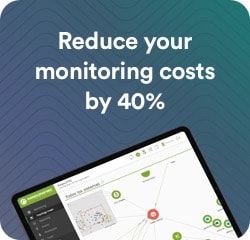Sections
- Definition and Relevance in Cybersecurity
- Evolution of Digital Forensics
- Fundamental Principles
- Applications in Cybersecurity and Incident Response
- Stages of a Digital Forensic Investigation
- Current Challenges in Digital Forensics
- Key Tools and Techniques
- Integration with Incident Response (DFIR)
- The Role of Pandora FMS in Digital Forensics
Definition and Relevance in Cybersecurity
Cyber forensics (also known as digital forensics, computer forensics, or digital forensic science) is the application of specialized techniques to collect, analyze, and investigate data retrieved from electronic devices—including deleted and recovered files—and cyber activities. Its goal is to carry out a structured investigation using documented evidence to help determine exactly what took place on a computing device and who was responsible for the security event or incident.
Differences from Traditional Cybersecurity
Cyber forensics essentially differs from traditional cybersecurity in its data recovery under legal compliance standards to ensure findings are admissible in legal proceedings. Additionally, forensic investigations aim to collect information in a way that preserves its integrity, enabling investigators to analyze the data or system to assess whether any modifications were made, how they came to be, and who carried them out.
Evolution of Digital Forensics
Origin and Development
For experts in the field, it is difficult to pinpoint the exact origin of digital forensics or identify the first computer forensic examination. However, everyone seems to agree that it began evolving in the 1970s, when techniques started being used to examine computing equipment for digital evidence. Key milestones include:
- Michael Anderson, a special agent with the U.S. Internal Revenue Service, is considered the father of cyber forensics for promoting the study of data storage, loss, and theft in 1988.
- In the 1980s, financial investigators and courts began to realize that, in many cases, records and evidence existed solely on computers.
- Norton DiskEdit introduced a tool for recovering deleted files.
- The Association of Certified Fraud Examiners began training its personnel in digital forensics.
Since then, digital forensics has continually evolved to counter cybercrime using increasingly sophisticated tools and techniques, along with regulations and standards conceived to support forensic digital investigations.
Key Regulations and Standards
Throughout the evolution of cyber forensics, multiple regulations and standards have emerged. It is essential to become familiar with the main ones to ensure the integrity of evidence and data usage right protection, including:
- International Standards: Best practices for forensic investigation, information handling, and processes related to evidence retention and disclosure.
- ISO/IEC 27037 – Global best practices for identifying, collecting, acquiring, and preserving digital evidence.
- NIST SP 800-86 – Guidelines for the analysis of cyber forensic evidence, widely used by academics and professionals.
- ISO/IEC 30121:2015 – A governance framework for managing digital forensic risks.
- Chain of Custody: Regulations concerning the maintenance of a clear chain of custody to ensure that evidence remains intact, high-quality, and legally admissible, based on:
- Digital evidence collection, including detailed records of the time, date, and condition of the device.
- Imaging and analysis, using exact replicas of the device’s hard drive to obtain intact and unaltered evidence.
- Transfer documentation, such as handovers between a technician and an analyst, with details including the purpose, date, and time.
- Courtroom presentation, proving that the evidence has not been altered or tampered with.
- Cross-Border Cooperation: Regulations between countries or regions concerning the admissibility of digital evidence in international legal proceedings. For example:
- Mutual Legal Assistance Treaties (MLAT) for the exchange of information and evidence in criminal investigations.
- European Union’s e-Evidence Regulation, which allows digital evidence to be requested from service providers in other member states.
- Cybercrime Initiative, aimed at coordinating international efforts to fight against cybercrime.
- Bilateral agreements between countries to share digital evidence and collaborate in cybercrime investigations. Examples include:
- UK-US Data Access Agreement, a treaty between the United Kingdom and the United States that enables direct requests for electronic data from telecommunications providers in the other country, targeting terrorism and child exploitation.
- CLOUD Act Agreement which allows the U.S. and the U.K. to bypass traditional legal barriers and access electronic evidence stored within each other’s jurisdictions.
- National Cybersecurity Policies: Many countries have their own specific legal frameworks to regulate digital forensic investigations, supporting both cybersecurity efforts and legal procedures. Examples include:
- NIST Cybersecurity Framework (United States) – A framework to reduce cyber risk through identification, protection, detection, response, and recovery.
- General Data Protection Regulation (GDPR) (European Union) – Designed to safeguard personal data and privacy.
- National Cyber Security Policy (NCSP) (India) – Aims to secure cyberspace by promoting awareness, strengthening infrastructure, and fostering collaboration between the private and public sectors.
- Cybersecurity Strategy (Japan) – Focused on protecting critical infrastructure and advancing cybersecurity-related research and development.
Fundamental Principles
In Digital Forensics, there are fundamental principles that ensure the integrity and reliability of digital evidence. These principles guide meticulous work in the collection, analysis, and preservation of data for legal and investigative purposes, including:
- Integrity: Ensuring that data remains unaltered from the time of collection through to its presentation in court. This includes maintaining a proper chain of custody (what was collected, when, and by whom it was received and preserved) to ensure the evidence remains intact, high-quality, and legally admissible.
- Process documentation and standardization: Keeping detailed records of all procedures and findings to maintain a clear chain of custody and ensure consistent processes.
- Preservation: Safeguarding digital evidence to prevent the loss or corruption of collected data.
- Analysis: Systematically examining data to uncover relevant information and patterns.
Applications in Cybersecurity and Incident Response
Forensic investigation plays a critical role not only in criminal investigations but also in strengthening cybersecurity efforts—an increasingly complex challenge in the digital era. Here are some examples:
Insider Threat Protection
A common and clear example is the leakage of confidential data by a disgruntled employee. With the right tools, it is possible to detect unauthorized access to sensitive files outside working hours and gather evidence of data transfer to external devices. The forensic team can analyze unusual activity logs to identify the user responsible and, through the chain of custody, compile clear and consistent elements for legal proceedings.
Cyberattack Investigation
In the face of rising malware, attacks, forensic investigation is key to analyzing ransomware incidents—from detecting the attack (identifying which systems were compromised), to taking actions to isolate affected systems or devices and prevent further spread, to malware analysis (understanding its nature, source, propagation method, etc.), to tracking the cybercriminal (using IP addresses and indicators to trace the attacker), and finally generating reports with findings and recommendations to remediate, strengthen security, and prevent future attacks.
Regulatory Compliance and Audits
Forensic investigation is effective in examining personal data breaches. Forensic experts investigate the incident, identify those responsible, and ensure that the organization implements corrective actions to comply with regulations such as the GDPR. Digital forensics also helps verify that internal policies and operational procedures align with applicable regulations, thereby avoiding legal penalties.
Incident Response Through Digital Analysis
Forensic investigation and incident resolution through digital analysis are integrated processes within information security management. This is because digital forensic investigation enables the collection of evidence (e.g., creating forensic images of affected devices) and detailed analysis to trace the root cause of the incident and identify the attacker (through malware analysis, IP tracing, and event correlation). Once the investigation is completed, incident management and resolution are carried out through digital analysis, involving:
- Immediate Response: Isolating compromised systems and attempting to stop the ongoing attack to minimize damage.
- Remediation: Repairing vulnerabilities and restoring affected systems, while ensuring they are protected against future attacks.
- Lessons Learned: Using forensic findings to implement preventive measures, such as enhancing security configurations or training personnel.
Stages of a Digital Forensic Investigation
Identification and Classification of Evidence
A digital forensic investigation begins with identifying the resources and devices or endpoints (PC, laptops, mobile phones, tablets, etc.) that contain data relevant to the investigation. These devices are confiscated and sealed to prevent any data tampering. If data is stored on a server, network, or cloud environment, access must be restricted solely to the investigation team.
Data Acquisition and Preservation
The forensic expert or analyst uses techniques to recover any data relevant to the investigation. This data is securely stored, and a digital replica or “forensic image” of the relevant data is created. The replicated data is then used for analysis and review.
Event Analysis and Correlation
At this stage, forensic experts rely on tools and methodologies to recover and examine relevant data, searching for evidence of misuse or criminal activity. Techniques may include:
- Reverse steganography, used to retrieve hidden information by examining the hash or character string behind an image or other data.
- Data recovery or file carving, which involves searching for any residual fragments of deleted files.
- Live analysis, which locates, analyzes, and extracts volatile data stored in RAM or cache while the operating system is running or during live analysis in a forensic lab.
- Keyword searches to locate and examine deleted data relevant to the investigation.
- Cross-drive analysis (CDA), a data extraction technique that allows investigators to examine data from multiple sources simultaneously.
Documentation
At the conclusion of the analysis, investigation results are documented in a way that clearly outlines the whole investigative process and its findings, including a timeline of the actions that led to the incident or attack.
Presentation
Findings are presented to a committee (or court) that will decide how to proceed (e.g., filing a lawsuit or initiating an internal complaint). Forensic investigators may serve as expert witnesses, providing a summary and presentation of the collected evidence and their conclusions.
Satges of a Forensic Investigation

Current Challenges in Digital Forensics
The fast pace of technological evolution is a major challenge itself, bringing with it increased legal complexities. Some of the key challenges to keep in mind include:
- Encryption and IoT Devices
Advanced encryption algorithms, along with the variety of operating systems and communication protocols, render evidence collection and analysis a complex and time-consuming task for your team. - Advances in Cybercriminal Tactics
Malware is becoming more sophisticated and will increasingly be used in targeted attacks, requiring forensic experts to stay continually updated. - Adaptation to Cloud and Mobile Environments
The decentralization of data in cloud environments and mobile devices—often stored on remote or even global servers—makes accessing and preserving digital evidence significantly more difficult. Other challenges include the shortage of skilled forensic investigators and the ongoing need for training to keep pace with the evolution of technology and cybercrime tactics. Additionally, data protection and privacy laws vary across countries and may restrict access to critical information during international investigations. Our recommendation is to engage with your technology partner to gain support in both technical knowledge and experience with best practices in forensic investigation.
Key Tools and Techniques
The success of a forensic investigation heavily relies on the use of appropriate tools and platforms, such as:
SIEM and Log Analysis
Security Information and Event Management (SIEM) and log analysis are essential for detecting, investigating, and mitigating security incidents. SIEM systems enable centralized log collection from multiple sources (servers, network devices, and applications), providing a comprehensive view of system activity. With this data, event correlation may be applied using rules and algorithms to associate seemingly isolated events—helping to identify suspicious patterns that may indicate a security incident. SIEM platforms may also generate automatic alerts when anomalies are detected, enabling quick response.
On the other hand, log analysis in forensic investigations reveals critical details for identifying the root cause of an incident, such as failed login attempts or unusual data transfers. It also enables the reconstruction of an attack timeline by identifying which systems were compromised. Detailed logging is also crucial for demonstrating compliance with security and privacy regulations.
Malware Analysis and Reverse Engineering
Malware analysis allows for suspicious file identification to determine whether they contain malicious code. This is followed by static analysis (studying the malware’s code without executing it, using disassemblers and code analysis tools) to understand its structure and operability; and dynamic analysis (executing malware in a controlled environment or sandbox) to see its performance in terms of network connections, file modifications, and/or processes created. With this, Indicators of Compromise (IoCs) are generated—unique patterns of the malware (IP addresses or file names)—to help in future attack detection and prevention.
Reverse engineering is applied to decompile the malicious software (into a readable format to understand its behavior and vulnerabilities); and to reconstruct algorithms (used by malware to encrypt data or evade detection) to develop defense and countermeasures. This enables attacker identification and their connection to threat actor groups.
Endpoint Protection and Intrusion Detection
Digital forensic investigation requires continuous monitoring constantly supervising devices to detect suspicious activity. Additionally, by analyzing endpoint usage and utilizing security tools (even with support from Artificial Intelligence), malware can be blocked before it affects company systems. Also, the information from protected endpoints can provide valuable logs for forensic investigation.
Intrusion Detection and Prevention Systems (IDS/IPS) identify and block malicious network activity, such as Denial of Service (DDoS) attacks. Additionally, network traffic logs collected by IDS/IPS help trace the source of an attack during a forensic investigation. With advanced SIEM and monitoring systems, it is possible to correlate potential intrusion events to gain greater context for a security event.
Cloud and Mobile Device Forensics
The cloud involves having data stored across multiple servers and geographic locations, which complicates the retrieval and analysis of data from devices for investigation. It is important to implement advanced techniques to ensure that data recovered from the cloud is not altered during the investigation process. For that reason, forensic specialists must use tools capable of retrieving information from smartphones, tablets, laptops, etc., including messages (email, text), call logs, and application data.
Artificial Intelligence Applied to Digital Forensics
Artificial Intelligence (AI) has become a powerful digital collaborator in digital forensics due to its ability to perform predictive analysis across large volumes and diverse sources; automate repetitive tasks; recognize patterns or anomalies; and carry out advanced malware analysis, including the creation of hypothetical scenarios, trends, and connections that might be difficult for human investigators to detect. As a result, AI is transforming digital forensics by accelerating processes and improving accuracy in digital investigations.
Integration with Incident Response (DFIR)
Digital Forensics and Incident Response (Digital Forensics and Incident Response, DFIR) combines two disciplines to address cyber threats: threat detection and mitigation, which enables the collection, preservation, and analysis of digital evidence to reconstruct incidents and support legal investigations, compliance audits, and improvements to security strategy; and incident response automation, which leverages the performed analysis to automate alerts and responses not only in real time but also proactively.
To carry out forensic work with your expert team computer forensics analyst/ investigator, digital forensic engineer, cybersecurity analyst, legal technology consultants, digital forensic examiners) whether from the security area or a Security Security Operations Center (SOC), it is essential to stay alert to the continuous evolution of cybercrime’s anti-forensic techniques, procedures, and methods. In these disciplines, real-time and contextualized monitoring data is the gold that defines the success of an integrated and efficient cybersecurity strategy.
The Role of Pandora FMS in Digital Forensics
Pandora FMS is a comprehensive monitoring solution for all elements within an IT infrastructure. It leverages data directly from source systems and software agents on devices and equipment, regardless of their location—whether inside the organization or extended environments such as cloud, Edge Computing, or IoT devices. It offers the following advantages for those undertaking digital forensics:
- Integration with SIEM: If you’re already a Pandora FMS user, you only need to activate the SIEM server to collect event information from the agents. This will automatically provide you with a robust SIEM for your team’s forensic work—without needing additional tools to obtain key information.
- Advanced Monitoring and Event Correlation: The integration of Pandora FMS and SIEM enables the combination of security events with real-time monitoring, including long-term historical data and raw logs, offering your expert team a more complete view. Additionally, with Pandora SIEM’s public and editable rules, you can enrich security event information and create advanced correlations that simplify the detection of suspicious patterns.
- Digital Evidence Collection: Real-time, secure, and consistent data enables the collection of reliable evidence in clear reports on security events—not only for your internal team, but also for your clients—addressing auditing and regulatory compliance needs, as well as legal processes.
- Benefits for Incident Response: Having a single platform with full observability accelerates and enhances the efficiency of your security and forensic teams in responding to incidents that require immediate, coordinated, and accurate action. It also provides reliable elements to support security orchestration and automation (SOAR), along with improvements to your security strategies from a multidisciplinary approach.
Try this solution by requesting your demo at this link.
Parlez à l'équipe de vente, demandez un devis ou posez vos questions sur nos licences









